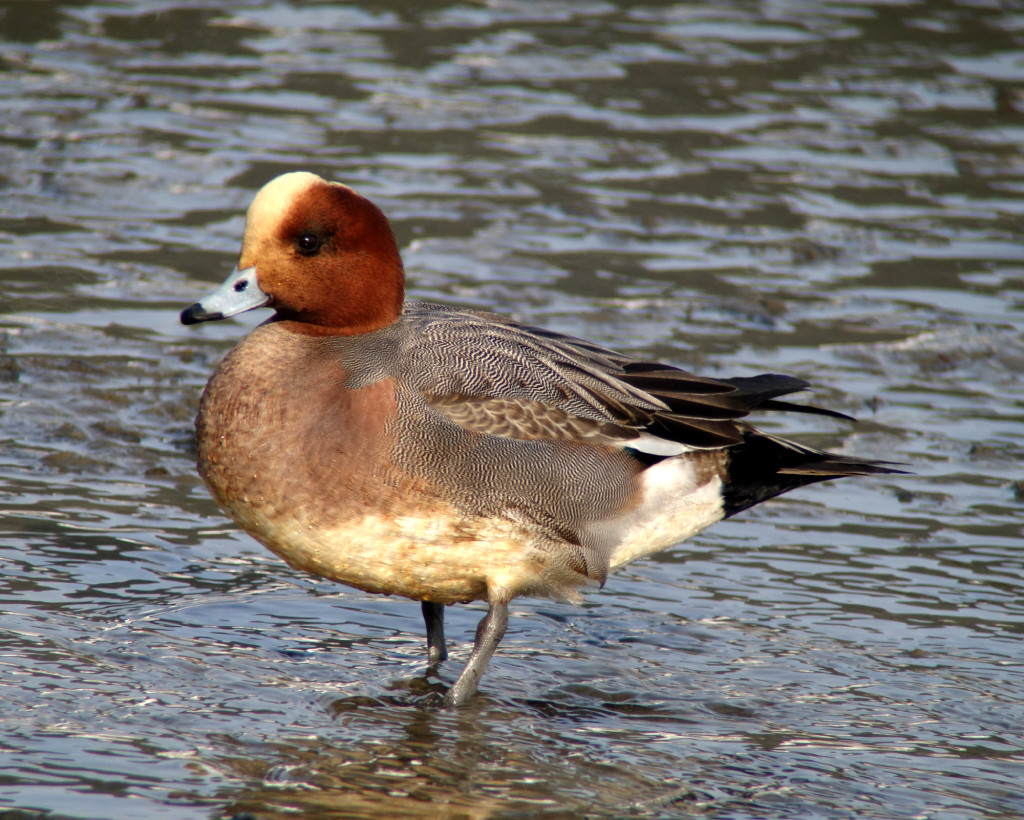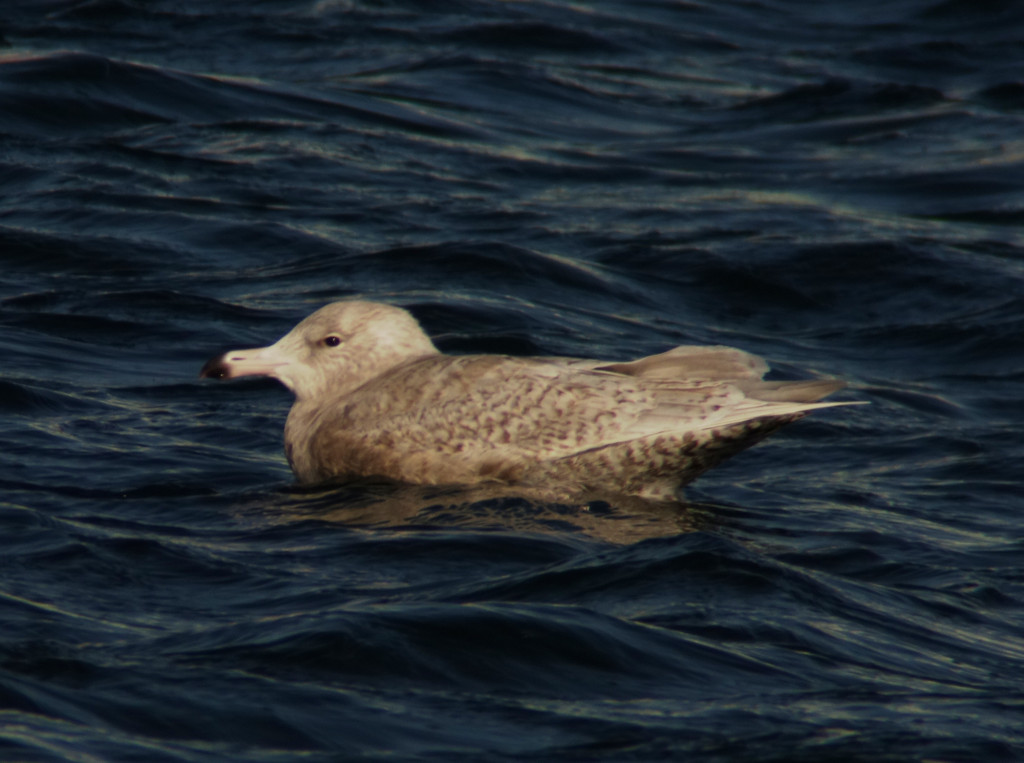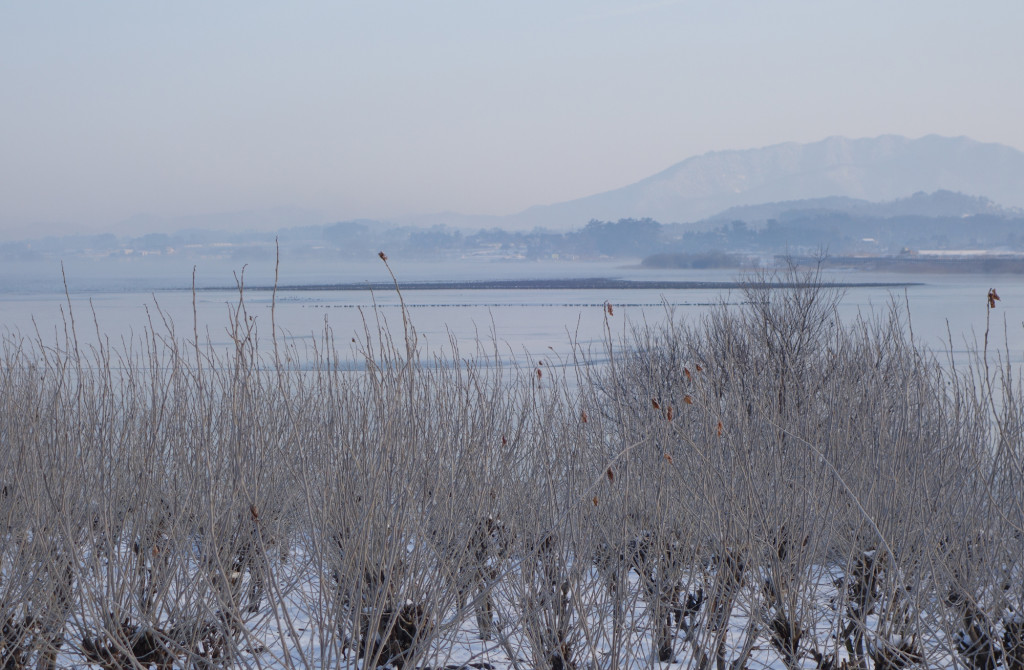This was the first trial visit to Korea by Zoothera Birding Tours, led by Nick Upton and Nial Moores with Peter Nickless and Graham Jones. In all, in spite of some exceptionally cold weather (with the most extreme temperature a high of -17C on a windswept mountain near Taebaek city), and rather limited time, we still recorded a total of about 164 bird species heard or seen, with probably 155 of these seen by all four members of our rather exclusive and obviously hardy group.
Our total included a long list of most-hoped for species, including 25+ Scaly-sided Merganser on NE River on the 19th; 12 Oriental Stork at Seosan on the 20th; and three Relict Gull and 30+ Saunders’s Gull feeding in among flocks of Eurasian Wigeon and Common Shelduck at the Geum Estuary on the 21st.
 First-winter Relict Gull Ichthyaetus relictus © Nial Moores
First-winter Relict Gull Ichthyaetus relictus © Nial Moores
 Adult Saunders’s Gull Chroicocephalus saundersi © Nial Moores
Adult Saunders’s Gull Chroicocephalus saundersi © Nial Moores
 Eurasian Wigeon Anas penelope © Nial Moores
Eurasian Wigeon Anas penelope © Nial Moores
On the 22nd, we found (at least) two Daurian Jackdaw in with a flock of 50,000 Rook near Buan and found 50,000+ Baikal Teal at a nearby frozen reservoir. In the afternoon, we then had excellent views of 400+ Hooded Cranes at Suncheon Bay.
 Baikal Teal Anas formosa flock on a frozen Dongrim Reservoir © Nial Moores
Baikal Teal Anas formosa flock on a frozen Dongrim Reservoir © Nial Moores
On the 23rd, highlights included an adult Steller’s Sea Eagle (and two more Relict Gulls) at the Nakdong Estuary followed by close views of a Swan Goose, two male Baikal Teal and 149 White-naped Crane at Junam.
 Swan Goose Anser cygnoides © Nial Moores
Swan Goose Anser cygnoides © Nial Moores
On the 24th, we encountered our first Harlequin Ducks along the east coast and saw our first Siberian Accentors and c. 200 Asian Rosy Finch near Taebaek. On the 25th, we had good views of a Long-billed Murrelet in Geojin; followed on 26th by close views of Ancient Murrelets and Spectacled Guillemots (c. 15 seen in total) from the boat out of Daejin.
On 27th, a mild mid-winter dawn by Cheorwon standards (-13C) was enlivened by flocks of Red-crowned (75+) and White-naped Cranes (200+) coming out of the DMZ, followed a few hours later by excellent views of three Solitary Snipe at the National Arboretum.
White-naped Crane Grus vipio © Nial Moores
 Solitary Snipe Gallinago solitaria © Nial Moores
Solitary Snipe Gallinago solitaria © Nial Moores
During the tour, in addition to widespread but nonetheless beautiful species like Varied Tit at several stops, additional highlights / bird species of note included a probable Saker (all but NM), an adult Lesser White-fronted Goose (NM and PN only?) and a personata Black-faced Bunting at Seosan on 20th; and on 21st a “Yellow Sea Gull” and a barabensis or barabensis-type gull in the Geum Estuary along with a flagged Dunlin (yellow or faded orange over white on the right, and a ring on the left enscribed with 133 over KVA).
 Varied Tit Sittiparus varius © Nial Moores
Varied Tit Sittiparus varius © Nial Moores
 Dunlin Calidris alpina © Nial Moores. Thanks to Spike Millington (Chief of the EAAFP) and Roger Standen (of the also wonderful AWSG) who tracked down the flags, we can now know(Feb 5th) that this bird was banded as a juvenile by Ivan Tiunov on Sakhalin between late August and mid-September in either 2010, 2011 or 2012.
Dunlin Calidris alpina © Nial Moores. Thanks to Spike Millington (Chief of the EAAFP) and Roger Standen (of the also wonderful AWSG) who tracked down the flags, we can now know(Feb 5th) that this bird was banded as a juvenile by Ivan Tiunov on Sakhalin between late August and mid-September in either 2010, 2011 or 2012.
Also on 21st, we watched a Bull-headed Shrike eating an impaled Olive-backed Pipit and chasing another one close to the frozen shoreline, and also found seven Light-vented Bulbul in Gunsan feeding in a mixed group that contained a dozen or more Brown-eared Bulbuls and single Naumann’s and Dusky Thrushes.
 Bull-headed Shrike Lanius bucephalus eating an Olive-backed Pipit © Nial Moores
Bull-headed Shrike Lanius bucephalus eating an Olive-backed Pipit © Nial Moores
 Light-vented Bulbul Pycnonotus sinensis © Nial Moores
Light-vented Bulbul Pycnonotus sinensis © Nial Moores
 Naumann’s Thrush Turdus naumanni © Nial Moores
Naumann’s Thrush Turdus naumanni © Nial Moores
At Suncheon Bay on the 22nd, we saw between one and four Common Crane and three or four Pied Avocet; and on 23rd found a Chinese Pond Heron and 2-3 Eurasian Hoopoe at Junam. On 25th, we found single Water Pipit and Chinese Grey Shrike at Yangyang and on 26th saw a very small and well-marked Glaucous Gull (subspecies barrovianus?) and two Glaucous-winged Gull in Daejin.
 Juvenile-type Glaucous Gull Larus hyperboreus © Nial Moores. This individual was smaller than several Slaty-backed and Vega Gulls immediately adjacent to it and also appeared very heavily and coarsely marked. It therefore looked very different from typical pallidissimus (the largest and palest of the Glaucous Gull subspecies) and seemed better to fit the description of barrovianus given by Malling and Olsen, in being “smaller than hyperboreus..Size, long wings and poor tertial steps create jiz similar to Iceland Gull especially in females…many (Juvenile/ First-winters) darker and more coarsely marked (than nominate); mantle and tertials often with stronger brown bars…Primaries often with darker outer webs…Bill as nominate but dark tip on average broader”.
Juvenile-type Glaucous Gull Larus hyperboreus © Nial Moores. This individual was smaller than several Slaty-backed and Vega Gulls immediately adjacent to it and also appeared very heavily and coarsely marked. It therefore looked very different from typical pallidissimus (the largest and palest of the Glaucous Gull subspecies) and seemed better to fit the description of barrovianus given by Malling and Olsen, in being “smaller than hyperboreus..Size, long wings and poor tertial steps create jiz similar to Iceland Gull especially in females…many (Juvenile/ First-winters) darker and more coarsely marked (than nominate); mantle and tertials often with stronger brown bars…Primaries often with darker outer webs…Bill as nominate but dark tip on average broader”.
On the 27th, we watched seven Mandarin Duck and one or two Common Treecreeper and Grey-capped Pygmy Woodpecker at the Arboretum; and saw another 300+ Mandarin at the Jungrang Stream the same afternoon.
 Mandarin Duck Aix galericulata © Nial Moores, at the National Arboretum (above) and on the Jungrang Stream in Seoul (below).
Mandarin Duck Aix galericulata © Nial Moores, at the National Arboretum (above) and on the Jungrang Stream in Seoul (below).
NM also glimpsed the male Baer’s Pochard that was first found and photographed by keen-eyed members of the University Birdwatching Club earlier the same day, and towards dusk we also saw an interesting hybrid duck of unknown parentage, that looked closest to Redhead (though with the wrong head-shape; and size similar to or smaller than accompanying Common Pochard).
 Hybrid pochard of unknown parentage © Nial Moores
Hybrid pochard of unknown parentage © Nial Moores
This short trip was also pretty successful for mammals, with Korean Water Deer on several dates; two to three Amur Leopard Cat seen running across ice at Seosan on 20th; and on 24th a Raccoon Dog in the river at Yeongdeok, three Roe Deer in roadside forest near Taebaek (GJ only) and a Wild Boar watched running across open fields on “Asian Rosy Finch mountain”.
 Wild Boar Sus scrofa © Nial Moores
Wild Boar Sus scrofa © Nial Moores
All images aboove were taken by NM, through a truly superb Swarovski scope…






The hybrid Pochard looks similar to one that was photographed at the same location last November, although that one was quite plum-coloured on the breast, whereas yours appears to be darker. To me it matches a C. Pochard X Ferruginous Duck hybrid as depicted on page 35 of the Collins Europe guide.
Thank you. Soon after watching this hybrid, a bird I knew nothing about, I was most surprised to be told by one of the finders that I had some time before identified it as a hybrid Common Pochard X Ferruginous (likely because of your comments on that earlier bird…) ! It seems obvious looking at the image (and less so in the field at dusk in the shivering cold) that one of its parents was a Common Pochard. Lacking enough experience, I would personally be hesitant to identify the other parent confidently as a Ferruginous (and would have liked to have seen the upperwing to learn if that showed anything helpful). All the same, I have been mailed by Marcus Nash, an expert on Ferruginous Ducks (and related hybrids) in the UK who, after looking at the image, also thinks it “looks just like a Ferruginous x Pochard hybrid”. A great-looking bird.